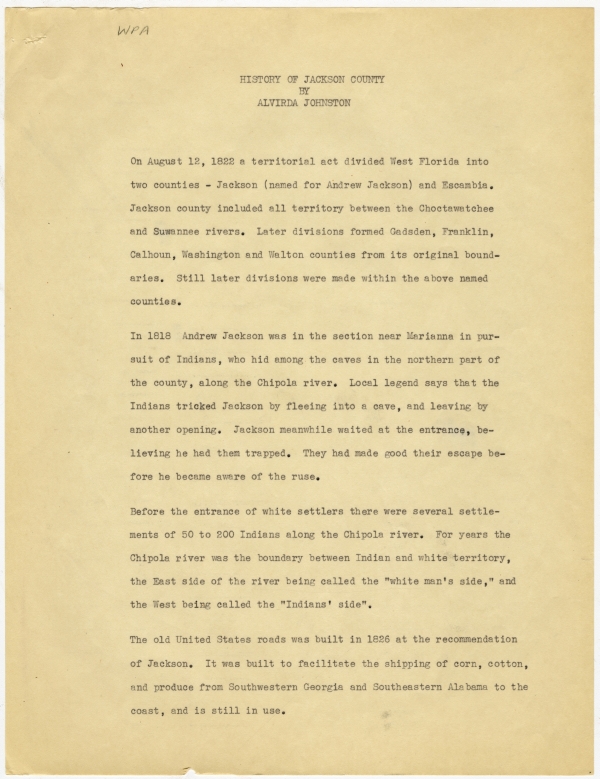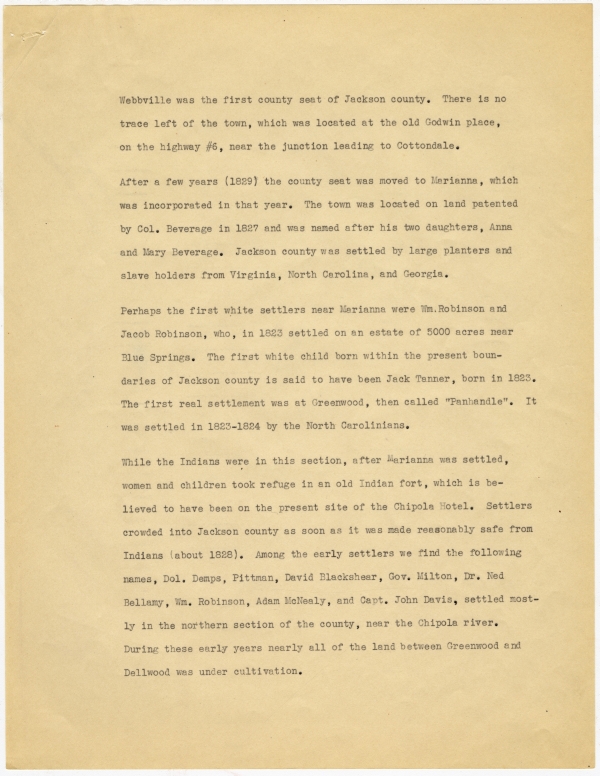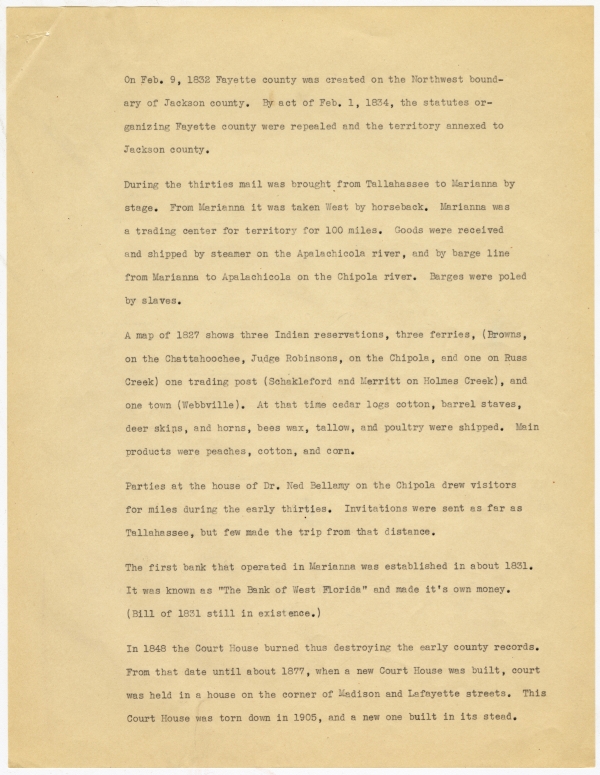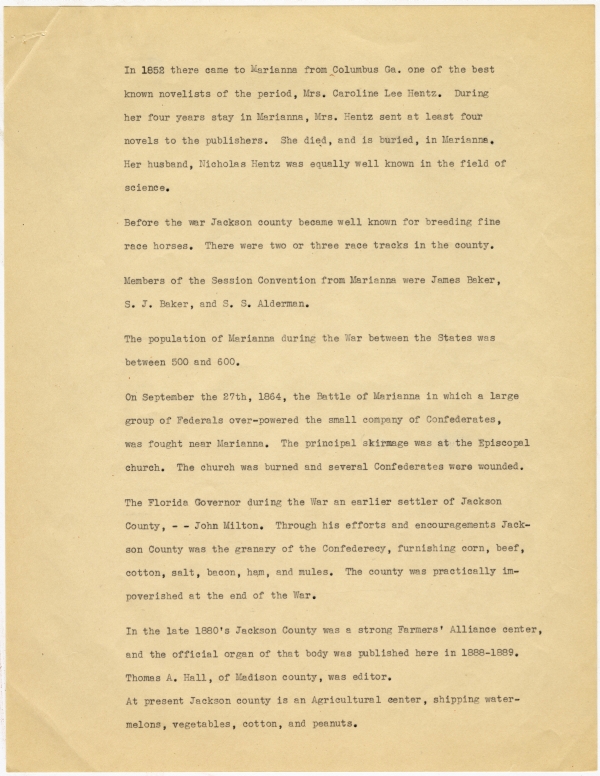Transcript
WPA
HISTORY OF JACKSON COUNTY
BY
ALVIRDA JOHNSTON
On August 12, 1822 a territorial act divided West Florida into two counties - Jackson (named for Andrew Jackson) and Escambia. Jackson county included all territory between the Choctawatchee and Suwannee rivers. Later divisions formed Gadsden, Franklin, Calhoun, Washington and Walton counties from its original boundaries. Still later divisions were made within the above named counties.
In 1818 Andrew Jackson was in the section near Marianna in pursuit of Indians, who hid among the caves in the northern part of the county, along the Chipola river. Local legend says that the Indians tricked Jackson by fleeing into a cave, and leaving by another opening. Jackson meanwhile waited at the entrance, believing he had them trapped. They had made good their escape before he became aware of the ruse.
Before the entrance of white settlers there were several settlements of 50 to 200 Indians along the Chipola river. For years the Chipola river was the boundary between Indian and white territory, the East side of the river being called the "white man's side," and the West being called the "Indians' side".
The old United States roads [were] built in 1826 at the recommendation of Jackson. It was built to facilitate the shipping of corn, cotton, and produce from Southwestern Georgia and Southeastern Alabama to the coast, and is still in use.
Webbville was the first county seat of Jackson county. There is no trace left of the town, which was located at the old Godwin place, on the highway #6, near the junction leading to Cottondale.
After a few years (1829) the county seat was moved to Marianna, which was incorporated in that year. The town was located on land patented by Col. Beverage in 1827 and was named after his two daughters, Anna and Mary Beverage. Jackson county was settled by large planters and slave holders from Virginia, North Carolina, and Georgia.
Perhaps the first white settlers near Marianna were Wm. Robinson and Jacob Robinson, who, in 1823 settled on an estate of 5000 acres near Blue Springs. The first white child born within the present boundaries of Jackson county is said to have been Jack Tanner, born in 1823. The first real settlement was at Greenwood, then called "Panhandle". It was settled in 1823-1824 by the North Carolinians.
While the Indians were in this section, after Marianna was settled, women and children took refuge in an old Indian fort, which is believed to have been on the present site of the Chipola Hotel. Settlers crowded into Jackson county as soon as it was made reasonably safe from Indians (about 1828). Among the early settlers we find the following names, Dol. Demps, Pittman, David Blackshear, Gov. Milton, Dr. Ned Bellamy, Wm. Robinson, Adam McNealy, and Capt, John Davis, settled mostly in the northern section of the county, near the Chipola river. During these early years nearly all of the land between Greenwood and Dellwood was under cultivation.
On Feb. 9, 1832 Fayette county was created on the Northwest boundary of Jackson county. By act of Feb. 1, 1834, the statutes organizing Fayette county were repealed and the territory annexed to Jackson county.
During the thirties mail was brought from Tallahassee to Marianna by stage. From Marianna it was taken West by horseback. Marianna was a trading center for territory for 100 miles. Goods were received and shipped by steamer on the Apalachicola river, and by barge line from Marianna to Apalachicola on the Chipola river. Barges were poled by slaves.
A map of 1827 shows three Indian reservations, three ferries, (Browns, on the Chattahoochee, Judge Robinsons, on the Chipola, and one on Russ Creek) one trading post (Schakleford and Merritt on Holmes Creek), and one town (Webbville). At that time cedar logs[,] cotton, barrel staves, deer skins, and horns, bees wax, tallow, and poultry were shipped. Main products were peaches, cotton, and corn.
Parties at the house of Dr. Ned Bellamy on the Chipola drew visitors for miles during the early thirties. Invitations were sent as far as Tallahassee, but few made the trip from that distance.
The first bank that operated in Marianna was established in about 1831. It was known as "The Bank of West Florida" and made it's own money. (Bill of 1831 still in existence.)
In 1848 the Court House burned thus destroying the early county records. From that date until about 1877, when a new Court House was built, court was held in a house on the corner of Madison and Lafayette streets. This Court House was torn down in 1905, and a new one built in its stead.
In 1852 there came to Marianna from Columbus Ga. one of the best known novelists of the period, Mrs. Caroline Lee Hentz. During her four years stay in Marianna, Mrs. Hentz sent at least four novels to the publishers. She died, and is buried, in Marianna. Her husband, Nicholas Hentz was equally well known in the field of science.
Before the war Jackson county became well known for breeding fine race horses. There were two or three race tracks in the county.
Members of the Session Convention from Marianna were James Baker, S. J. Baker, and S. S. Alderman.
The population of Marianna during the War between the States was between 500 and 600.
On September the 27th, 1864, the Battle of Marianna in which a large group of Federals over-powered the small company of Confederates, was fought near Marianna. The principal skirmage was at the Episcopal church. The church was burned and several Confederates were wounded.
The Florida Governor during the War an earlier settler of Jackson County, -- John Milton. Through his efforts and encouragements Jackson County was the granary of the [Confederacy], furnishing corn, beef, cotton, salt, bacon, ham, and mules. The county was practically impoverished at the end of the War.
In the late 1880's Jackson County was a strong Farmers' Alliance center, and the official organ of that body was published here in 1888-1889. Thomas A. Hall, of Madison county, was editor.
At present Jackson county is an Agricultural center, shipping watermelons, vegetables, cotton, and peanuts.
REFERENCES FOR HISTORY
OF
JACKSON COUNTY
W. H. Milton - Marianna, Fla.
W. T. Cash - Tallahassee, Florida
Anderson Bowles - Marianna, Fla.
Mrs. Cecil Rhyne - Marianna, Fla.
J. D. Smith - Marianna, Fla.
Mrs. Hugh Middlebrooks - Marianna, Fla.
Emmett Shepherd - Marianna, Fla.
F. W. Hoskins - Panama City, Fla.
Jackson County Floridan; 1935-1936 (Newspaper)

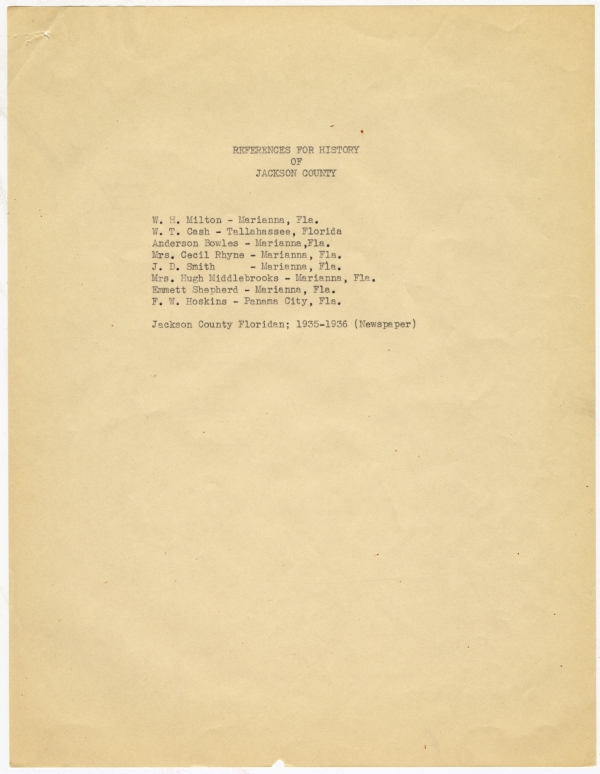


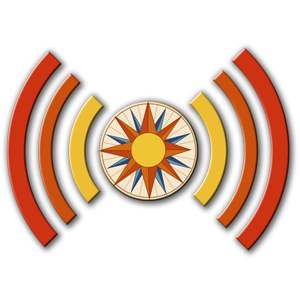 Listen: The Bluegrass & Old-Time Program
Listen: The Bluegrass & Old-Time Program